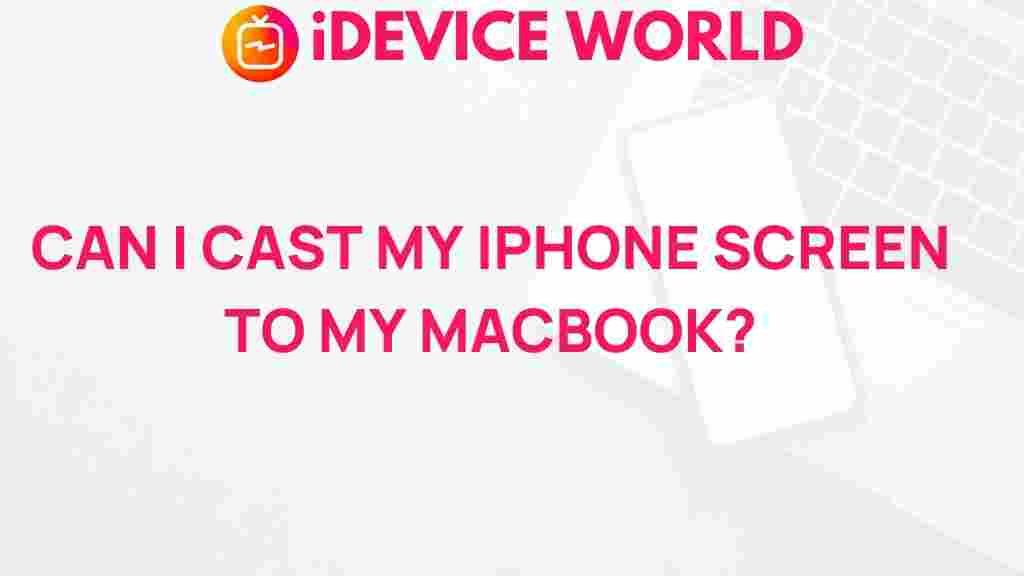Unlocking the Mystery: How to Cast Your iPhone Screen to Your MacBook
In today’s digital age, the ability to share content seamlessly across devices is more important than ever. Whether you want to showcase photos, presentations, or even gameplay, knowing how to cast your iPhone screen to your MacBook can greatly enhance your experience. This guide will take you through the steps necessary to unlock this capability, ensuring you can effortlessly mirror your iPhone screen to your MacBook.
Understanding the Basics of Screen Casting
Before diving into the steps, let’s clarify what screen casting is. Screen casting allows you to display your device’s screen on another device. This feature is incredibly useful for:
- Presenting content in meetings.
- Sharing videos or photos with friends.
- Playing games on a larger screen.
- Demonstrating apps or features on your iPhone.
By casting your iPhone screen to your MacBook, you can leverage the larger display, making it easier for multiple people to view content together.
Requirements for Casting Your iPhone Screen to Your MacBook
To cast your iPhone screen to your MacBook, you’ll need:
- A compatible iPhone (iPhone 5 or newer).
- A MacBook running macOS Monterey or later.
- A stable Wi-Fi connection.
With these requirements met, you’re ready to start the screen casting process.
Step-by-Step Guide to Cast Your iPhone Screen
Now, let’s walk through the process of casting your iPhone screen to your MacBook:
Step 1: Ensure Both Devices are Connected to the Same Wi-Fi Network
Your iPhone and MacBook must be connected to the same Wi-Fi network to enable screen casting. Check the Wi-Fi settings on both devices to confirm.
Step 2: Enable AirPlay on Your MacBook
1. Click on the Apple logo in the top left corner of your MacBook’s screen.
2. Select “System Preferences” from the drop-down menu.
3. Click on “Displays.”
4. Check the box that says “Show mirroring options in the menu bar when available.”
Step 3: Open Control Center on Your iPhone
1. Swipe down from the top right corner of your iPhone screen (for iPhones with Face ID) or swipe up from the bottom (for older models).
2. Look for the “Screen Mirroring” option and tap on it.
Step 4: Select Your MacBook
In the Screen Mirroring menu, you should see your MacBook listed. Tap on it to initiate the connection. If prompted, enter the code that appears on your MacBook’s screen to complete the pairing process.
Step 5: Enjoy Your Content
Once connected, your iPhone screen will be mirrored on your MacBook. You can now showcase your apps, photos, or anything else you wish to share.
Troubleshooting Common Issues
Sometimes, despite following the steps, you may encounter issues while trying to cast your iPhone screen. Here are some common problems and their solutions:
Issue 1: Unable to Find Your MacBook in the Screen Mirroring Menu
Solution: Ensure both devices are on the same Wi-Fi network. Restart your Wi-Fi router if necessary. Also, check if AirPlay is enabled on your MacBook.
Issue 2: Poor Quality or Lagging Screen
Solution: This could be due to a weak Wi-Fi signal. Ensure that both devices are close to the router, or consider switching to a less congested network.
Issue 3: No Sound from the MacBook
Solution: Make sure that the sound settings on your MacBook are set to the appropriate output device. You can adjust this in the “Sound” section of System Preferences.
Advanced Tips for Casting Your iPhone Screen
For those looking to optimize their experience further, consider these advanced tips:
- Use a USB-C or Lightning Cable: If you want a more stable connection, consider using a cable to connect your iPhone directly to your MacBook.
- Explore Third-Party Apps: There are several third-party applications available that can enhance your screen casting experience, such as Reflector and AirServer.
- Check for Updates: Always ensure your iPhone and MacBook are running the latest software versions to avoid compatibility issues.
Conclusion
Knowing how to cast your iPhone screen to your MacBook can open up a world of possibilities for sharing content and enhancing presentations. By following the steps outlined in this guide, you can easily connect your devices and start showcasing your content in no time. If you encounter any issues, remember to consult the troubleshooting tips provided, and don’t hesitate to explore advanced options for an even better experience.
For more information about using Apple products together, check out this comprehensive guide on Apple support. And if you’re looking to enhance your MacBook experience, explore some must-have apps that can help you get the most out of your device.
This article is in the category Guides & Tutorials and created by iDeciveWorld Team
